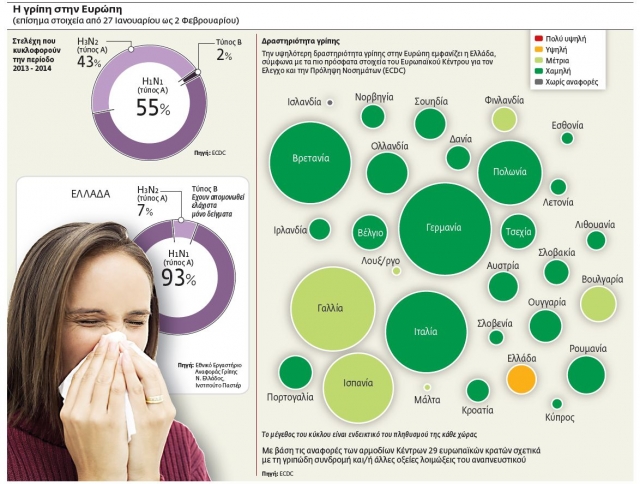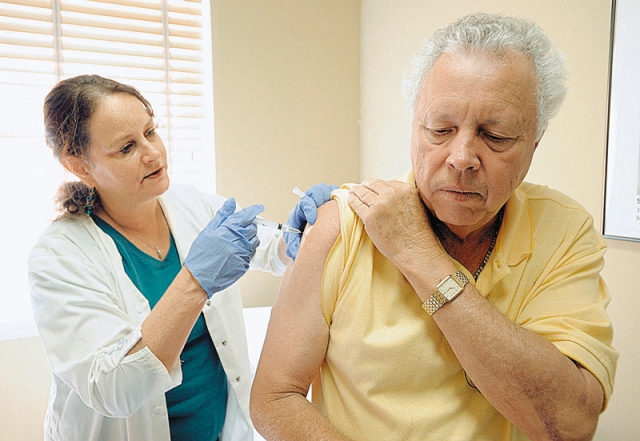Greece ranks first in Europe but unfortunately only in terms of influenza activity as shown by the latest survey of the European Centre for Disease Prevention and Control (ΕCDC), covering the period from the last days of January to 2 February. The European Centre notes that of the 29 European countries providing clinical data, the highest influenza activity was recorded in Greece whereas it was moderate in Bulgaria, Finland, France, Luxembourg, Malta and Spain. Influenza activity in the other 22 European countries included in the survey was low in the same period.

Be patient until April
Professor Sotiris Tsiodras, a specialist in infectious diseases at the Hellenic Centre for Disease Prevention and Control and a teacher at the Medical Faculty of Athens University states for "To Vima" newspaper, "At present, if a person has flu-like symptoms such as fever, cough, headache, aching muscles and bones, the probability of him or her actually being infected with the influenza virus is greater than 50%. We believe that influenza activity has peaked this year much earlier than last year, when the influenza wave was just beginning at that time. Furthermore, we believe that the high activity will continue for another two weeks and then it will begin to decline, so that it will reach low levels in late March or early April."

According to the Hellenic Centre for Disease Prevention and Control, 133 people were admitted to intensive care wards and 32 cases of death ware recorded up until Thursday night. Sotiris Tsiodras explains that "these severe cases and fatalities mainly refer to members of high-risk populations, especially those with chronic respiratory diseases. The average age of deceased patients is lower than last year and now it is about 55 years." He also notes that only 46 serious cases and 12 deaths were registered at this time last year.
Influenza strains
What is the main culprit for this year's onslaught of flu in Greece? Director of the National Laboratory for Influenza at Pasteur Institute Andreas Mendis states before the same newspaper that strain Η1Ν1, or the so-called swine flu, has been isolated in the majority of the cases (over 90%). Strain Η3Ν2 has been isolated in a very small percentage of the cases which, along with Η1Ν1, is a subtype of influenza A, whereas very few cases have been connected with influenza B. During this period, however, other respiratory viruses are circulating, including the respiratory syncytial virus and rhinoviruses.
According to Andreas Mendis, however, the genetic analyses of the strains circulating this year show that, fortunately, they are amenable to the preventive and oppressive "weapons" available to physicians. "We have not noticed anything unusual about this year's flu strains. Therefore, the vaccine is effective against them as well as antiviral drugs."
Why are there victims?
Since we are dealing with known strains of influenza, one might however wonder why there are so many deaths this year. Professor Tsiodras replies, "Probably people from high-risk groups have weak immunity to this virus, perhaps many people from this group were not affected by Η1Ν1 last time. However, the shortage of vaccines is a serious problem and there may be a small mutation of the strain that allows it to spread again."
Vaccination or rather failing to be vaccinated against the influenza virus allows the virus to weaken the population as stated by Jenny Kourea-Kremastinou, head of the Hellenic Centre for Disease Prevention and Control and a teacher at the National School of Public Health. "Although we do not have this year's official reports, probably the percentage of vaccination among the risk groups of the population does not exceed 20% - 30% whereas at least 75% of these groups should be vaccinated."

Physicians and nurses are not vaccinated either
The problem is even greater considering the fact that another group which should be vaccinated also reports a record high number of unvaccinated people. These are the medical staff, including physicians and nurses. Previous studies had shown that only 10% - 15% of them were vaccinated against flu. This year things are even worse and perhaps it is the state’s fault to some extent because the previous leadership of the Ministry of Health has discontinued the free provision of vaccines for health care workers, forcing them to obtain a prescription from a physician and then to buy the vaccine at a discount from a pharmacy. So, the percentage of vaccinated medical staff, which was low anyway, has further decreased.

According to experts, however, it is not too late, at least for the risk populations, to be vaccinated. It takes seven to ten days to develop antibodies and, in view of the fact that the flu wave will continue until April, maybe these groups will be able to protect their health. It should be noted however that it is now very difficult to find vaccines because only small quantities of them are available in the market.
How to use antiviral drugs?
When influenza has knocked on our door, the solution is antiviral drugs. Here are some tips from the Hellenic Centre for Disease Prevention and Control for their proper intake:
- All members of high-risk groups (including people with chronic respiratory and cardiovascular diseases and diseases of the immune system, the elderly, etc.) should take, as prescribed, antiviral drugs during the first two days of the onset of flu symptoms, even if there is no laboratory confirmation of the disease.

- As for the people who do not belong to high-risk groups, if they notice serious symptoms such as persistent high temperature of over 40 degrees, spasms or cyanosis, or symptoms of the central nervous system such as hallucinations during the first day after the onset of symptoms, they should immediately take antiviral drugs.
- For all other people, in whom the disease occurs more easily, the treatment is ... a rest at home. Until the symptoms, such as cough and fever, are apparent, from three to five days on average, these people need to stay at home in order not to torment themselves and not to expose others to the virus (as is known, each of us may infect others one to two days prior to the onset of symptoms and while they last). During the home treatment, the patient should regularly monitor his or her temperature, take antipyretics, eat high-calorie food, drink plenty of liquids and should naturally observe personal hygiene so as not to infect his or her family. It is also important to know that in the case of a relapse, while the patient believes that the flu has passed, he or she should immediately visit a doctor because of the risk of a secondary infection (probably a bacterial one) that requires appropriate treatment.

Misleading measurements
Be careful with rapid tests!
The Pasteur Institute announced last week that the National Influenza Laboratory of the Institute had received reports of unsatisfactory results of the so-called rapid tests for the diagnosis of influenza. Director of the Laboratory Andreas Mendis states that "the existing laboratory studies show that the sensitivity rate of these tests is approximately 40% - 60%, which means that if a test is negative, that does not mean that the person is not a carrier of the virus. So, if there is serious suspicion of influenza molecular testing is required."

It should be noted that a number of private centres and hospitals offer rapid tests and their results are ready in about a quarter of an hour whereas several hospitals, private centres and the Pasteur Institute offer molecular testing, the results of which come out within about three hours (depending on the equipment of the laboratory this may take longer). Here is the advice of Andreas Mendis in this situation, "The main question is who really needs to be tested for establishing and determining the type of influenza virus. If this person does not belong to high-risk populations, who will not be subject to special treatment even if his or her result is positive, then there is no reason for this person to be tested. However, if there are reasonable grounds to establish whether the patient is suffering from flu, then the exact solution is molecular testing."
Η10Ν8
Another threat made in China
Scientists fear a new strain of bird flu that has already occurred in China as it can spread throughout the world. This is Η10Ν8, which has already taken the life of its first victim, namely a 73-year-old woman in the Chinese city of Danchang, Tsiangsi province. She was probably infected with the disease when she visited a bird market. A second case has been registered in the same province in which a 55-year-old woman has been admitted to hospital in critical condition. Scientists have not previously observed this strain, which is a subtype of influenza A and have expressed concern at the fact that it may be transmitted from birds to humans. In a publication released a few days ago in the prestigious medical journal "The Lancet", experts from the Chinese Centre for Disease Prevention and Control in Beijing stress the following: "The epidemic potential of this new strain should not be underestimated. The data show that the Η10Ν8 strain continues to circulate and may cause more cases of disease among people in the future." In the article, the specialists emphasise the fact that this is the fifth new strain of influenza that has emerged over the past 17 years. "It has a disturbing genetic profile and it should be closely monitored. It seems that it can damage the tissues deep in the lungs, easily spreading in the human body", Chinese scientists write, adding that the main fear is that, at some point, Η10Ν8 will start to be easily transmitted from person to person, although no signs of this have been observed for the time being. It should also be noted that since last year China has fought against the invasion of a similar strain, namely Η7Ν9, which killed a quarter of those infected with it.
Commenting on the emergence of this new strain professor Tsiodras from the Hellenic Centre for Disease Prevention and Control stresses that "both Η10Ν8 and Η7Ν9 are "cousins" of the Η5Ν1 strain, which originally appeared in Asia in 2003. Although it has not developed the ability of being easily transmitted between people (the main source of infection has always been birds), it has killed over 50% of the people infected with it. In any case, it seems that these strains are transmitted only after a close contact between humans and birds. This is a new potential threat but we have not detected the major mutation that would allow it to be easily transmitted."